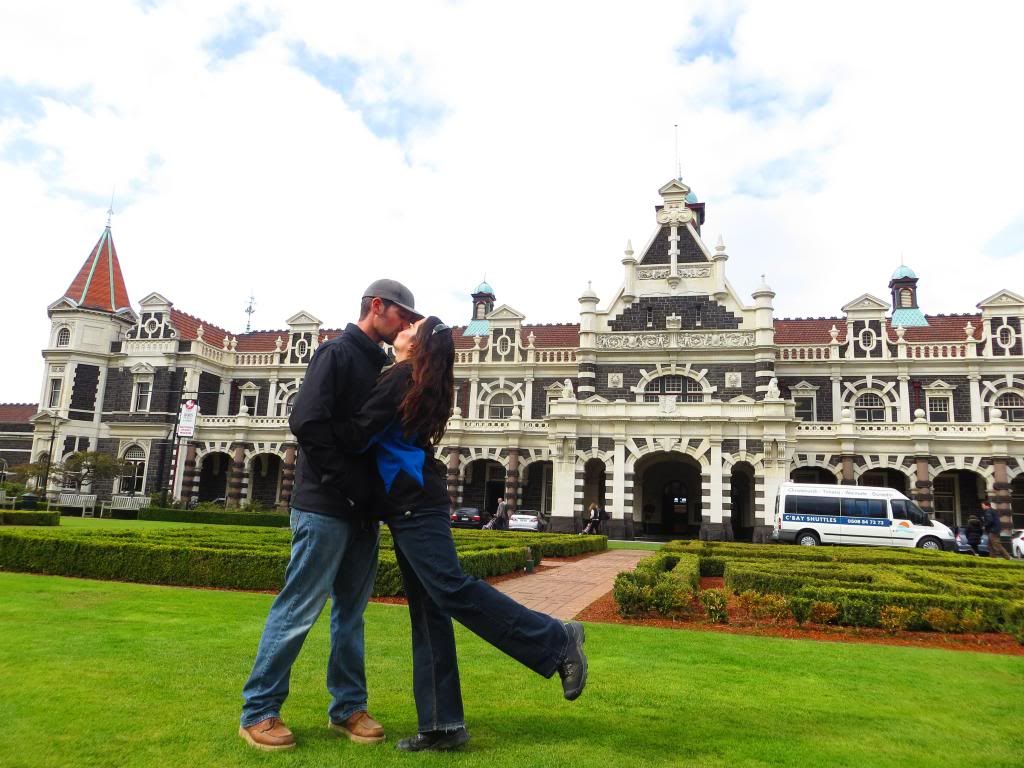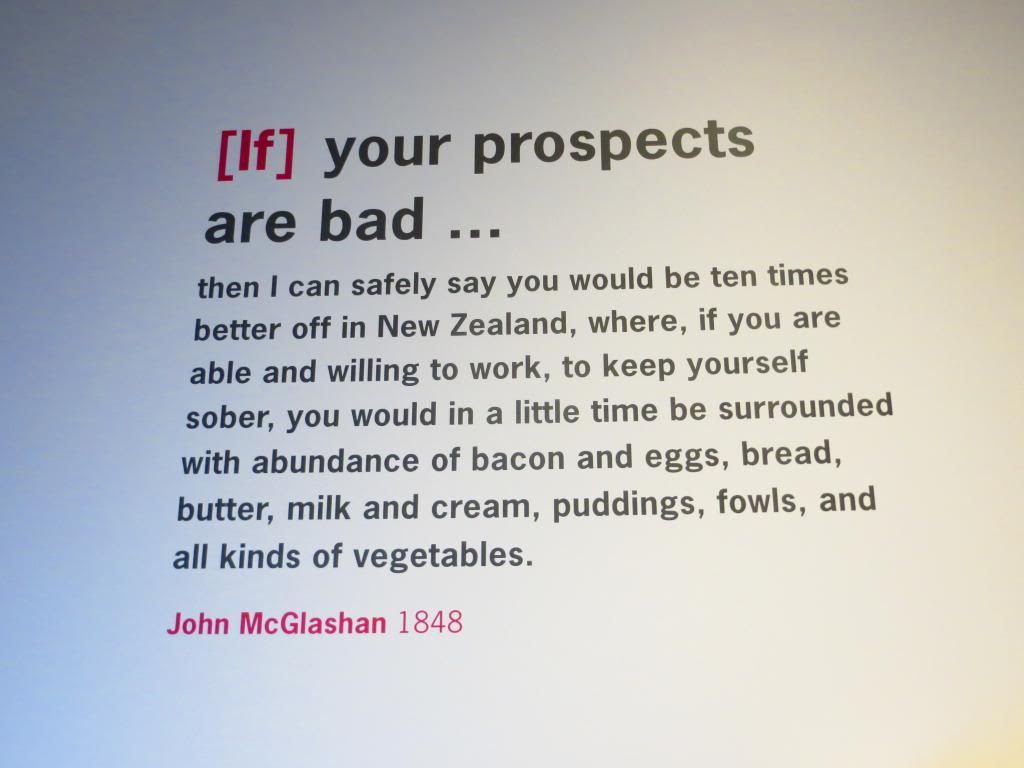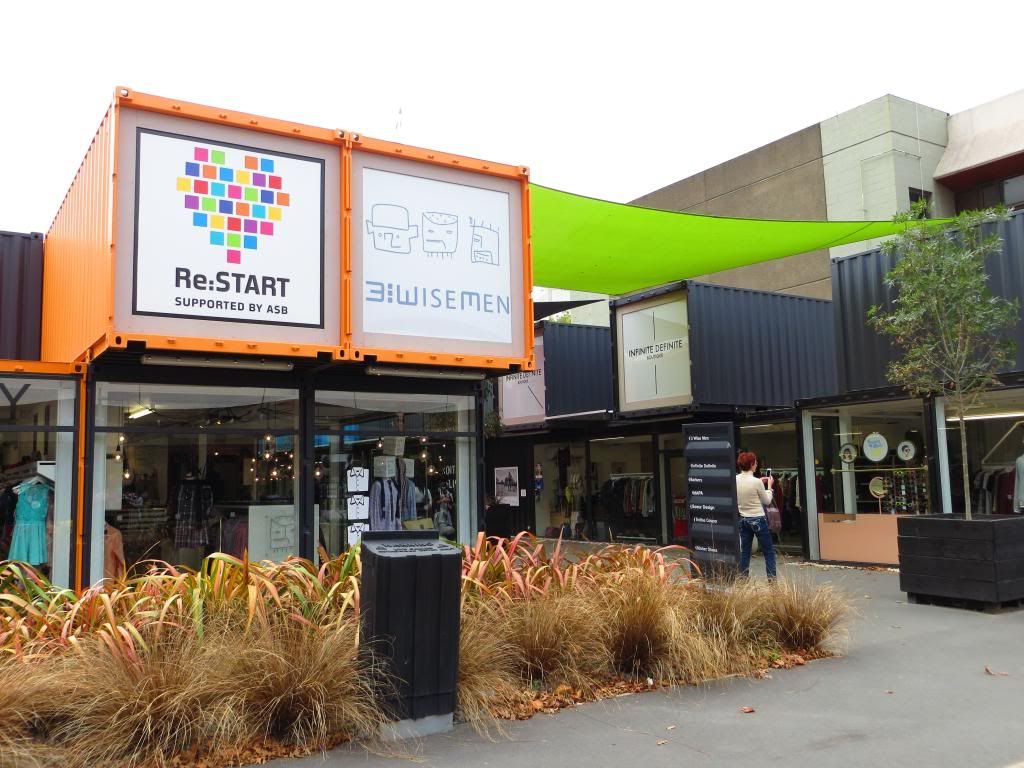From The Ashes
DUNEDIN/OAMARU/CHRISTCHURCH, NEW ZEALAND: April 8-15, 2013
Leah: Having bid
the Pringle family their assorted animals farewell, we made our way to coastal
Dunedin (which is “New Edinburgh” in Gaelic), the first city in NZ and a place
I remembered fondly from my 2006 NZ visit. We planned to spend a few days in
this bustling university city steeped in bucolic history; once settled into our
accommodation we made our first game plan and followed the smell of hops to the
Speight’s Brewery a quick walk away.
Speight’s Gold Medal Ale is the best selling beer in NZ and
for good reason—it’s one of the oldest breweries in the country and sits right
on top of its own crystalline spring water. In fact, they have a tap on the
street where anyone can fill water bottles with this pure water and one of the
local papers even pulled an April Fool’s joke a few years back where they ran a
story saying that the Speight’s water tap was now dispensing beer as a result
of a technical pipe glitch. Apparently the lines were around the block with
(sorely disappointed) people waiting to fill every available vessel with beer.
Hysterically cruel.
Anyway, this brewery tour was the real deal at over an hour
long with museum quality displays and tour covering four floors, including vast
copper brewing kettles that were more a work of art than anything else. We even
learned that due to the 2010 Christchurch earthquake the Speight’s brewery
there was destroyed and right before St. Patrick’s Day to boot. This is
important because that was the only NZ brewery licensed to brew Guinness; as a
result, the Dunedin location needed to apply to Ireland for an emergency permit
to brew this St. Patty’s Day staple and all was well…in terms of beer, that is.
The tour culminated in their tasting room where we were
given free reign over their taps dispensing 6 different brews for about half an
hour. Luckily for this gal they had a delectably dry cider on tap, so while
Steve sampled his way down the line I stuck with my tried-and-true and everyone
was happy. Not a bad start to our Dunedin sojourn, especially because Michelle
(Pringle) had given us a coupon for a 2-for-1 tour and we received a further
discount because we were doing the Cadbury Factory tour the next day, so for a
grand total of $22 NZD (about $18.50 USD), we enjoyed a fascinating and
historical tour as well as an open bar. Not too shabby and we followed that up
with a 2-for-1 Irish pub comfort food dinner thanks to another coupon from
Michelle. Hell yeah! Now all we had to do was figure out a way to avoid our dorm
mate back at the hostel who we had affectionately dubbed “50 Shades”. A young
Dutch guy, he spent his evenings under the covers in only his underwear reading
50 Shades of Grey. We were slightly
skeeved out and did our best not to laugh in his face/run away in disgust and
fear.
Our second day was a whirlwind, starting with our 10 a.m.
tour at the Cadbury Chocolate Factory, another Dunedin slice of history (and
another ½ price excursion thanks to a coupon: $19 NZD total). After loading my
pockets with bitter cacao nibs from the sample basket we joined the rest of our
tour group, donned some sexy hair/beard nets and followed our host Lynne as she
led us through the ins and outs of this confectionary heaven. Samples awaited
at almost every turn and we felt like kids at Halloween as we were repeatedly
instructed to open our plastic bags so Lynne could fill it with chocolate
goodies. As our sugar levels soared we saw (and smelled) production lines, hand-packaging
and even the color-coded pipes carrying the necessary ingredients overhead.
This olfactory explosion was a great way to start the day and somehow we
exercised extreme restraint in the retail shop and only bought two individual
reduced Easter goodies for $0.50 each.
From Cadbury’s we bounced—quite literally thanks to our
soaring insulin levels—next door to the Otago Settler’s Museum. This museum
re-opened in December of 2012 as a marvel of architecture and technology married
together in an effort to bring Dunedin’s eclectic history to life. The display
cases all featured touch-screen computer portals that allowed you to pick and
choose which pieces of the exhibit to learn more about. There was a re-created
ship’s berth to meander through, period clothing to try on, audio and visual
stories and voice-overs throughout and (often hysterical) ads and appliances
from the last century that brought this former mud-covered settler city to
life.
After our brain saturation levels reached a critical point,
we walked next door to the Dunedin Chinese Garden, where not only did we have a coupon for
2-for-1 admission, but another one for a free pot of tea. Yes dear readers, clearly
my couponing addiction has not receded with time or distance! The gardens were
a lovely respite in the middle of the bustling city and we marveled at the harmony
of water, rock and plants—the manmade and the natural—and the exquisite details
that had us both drawing a breath at every twist in the path. We were able to
try on traditional Chinese attire and sipped our delicately flavored lychee tea
from tiny ceramic cups while overlooking the wishing tree in the courtyard.
Perfection.
The following day had us face the fact that we are in indeed
adults of a certain age and aren’t quite part of the younger backpacker crowd
anymore. Namely, we awoke with excitement toward our trip that that day on the
Taieiri Gorge Railroad,
a train trip that I would have whinged to my parents over a decade ago to
please not make me go on due to perceived boredom. Another slice of history,
this railway was used during the gold rush and as the only way to transport
goods and livestock to remote reaches of the area decades ago. Even the bridges
were a feat of incredulous engineering, as the laborers who built them were
untrained and had never worked in masonry before, yet the quarried the rock
from nearby the tracks and created stone bridges and trestles with naught but
trial and error and perseverance. In fact, they did such a bang up job that
modern engineers have studied their work and remarked with surprise that they’re
just as strong and supportive now as they were then. So there we sat for an
afternoon, chins on our hands staring at the varied scenery and listening to
the conductor’s commentary as we reflected on a bygone era and struggled not to
fall asleep to the clattering and swaying of the carriage. Yup, we are now
officially old enough where we decide to splurge on a slow train trip to
nowhere and back—can’t say I’m sad about it either!
From Dunedin we made a one night stopover in the seaside
hamlet of Oamaru to see the blue penguins, the smallest penguins in the world.
They nest in colonies right around town but since we didn’t know what to look
for or where exactly to go, we forked over $20NZ each at the Blue Penguin Colony to get up close and personal for when they
arrived just after dusk. I have only seen penguins once in the wild before (and
Steve never has), but this experience was unreal and unlike any other. As we
sat there squinting at the ocean in the near-dark, Steve pointed out what
appeared to be flotsam in the distance. However, as we watched, it approached a
lot faster than seaweed or driftwood should and soon we could make out a
penguin formation, or “raft”, with their white breasts and dark backs. As they
crested the breakers and slid into shore in a tumbling and belly-flopping unit,
we could hear their distinctive vocalized calls as they quorked back and forth making sure everyone was there. A steep hopping waddle up the beach and
these little lovebugs were safe in the refuge of their nesting boxes or nestled
in the nooks and crannies of the rocks below.
The blue penguins mate for life and typically return to
shore in a raft formation for safety in numbers. They lay two eggs at a time
and in a really good season they may have two clutches at different times; the
chicks are on their own at 8 weeks and for that reason only about 30-40%
survive their first year. They can also stay out at sea for days, weeks or
months at a time, coming up and sleeping on the surface on the water, although
they apparently only need a few minutes of sleep each night (apparently the
ones in the research colony chatter back and forth all night until they leave
before dawn to go fish). We saw 3 different rafts come to shore and each time
was just as thrilling as they meandered their way up the rocky shoals. I vowed
to say ‘hi’ to their bigger cousins in Antarctica when we get there later in
life! On the way back to the hostel we played spot the penguin and saw little
feathered blobs huddled under overturned boats, nestled against fences and
basically snoozing anywhere dark and cozy (the adults have no land predators,
as the weasels and possums only eat the eggs and chicks). We weren’t allowed to take pictures, as it
greatly disturbs these little guys—sorry!
Next stop: Christchurch (Chch) and we were attempting to
hitchhike again, though we were understandably wary after our luck in the South
Island. Our first ride took us almost 2 hours of waiting and got us 10 minutes
up the road as we chatted with Leo (from Argentina) and his girlfriend Matai
(from Brazil) who work on a dairy farm. We ate some lunch roadside and headed
back out to thumb, fully realizing that we’d probably fall short of Chch and
would be happy to get as far north as we could given the late hour. However,
after 15 minutes our road savior came in the form of John, a former Brit who
moved down to NZ almost 20 years ago with his wife to teach high school and has
since changed careers and now works as a union organizer for the rail and port
workers. Needless to say, we didn’t run out of questions or conversation topics
during the 3 hour ride and we learned that not only had our driver cycled from
Denver to Los Angeles, but that he grew up the son of an avowed English
communist father, which actually helped him nail his union job. The time flew
and before we knew it the flat, irrigated Canterbury Plains had given way to
the industrial area of Chch; John dropped us right in the parking lot of the
holiday park where we would be camping and headed back to his wife for a
relaxing weekend.
We decided to employ the use of our trusty tent for one last
hurrah since camping would allow us a nightly rate ½ that of a hostel and our
holiday park was a walkable 4 km from the city center or a quick bus ride away.
However, the affable owner behind the counter raised his eyebrows when we told
him we wanted to camp and incredulously said, “It’s gonna be pretty cold at night
now!” We assured him we were no strangers to camping in the cold and snow and
his hesitation assuaged, he showed us to our site. There was no way we’d make
into town that night, so we trundled off to the grocery store to find food that
could be cooked using only a skillet and a spatula. Since this is a holiday
park and not a hostel, most everyone travels in an RV or campervan and has
their own cooking utensils, cutlery, etc. We only have two mugs and a few forks
between us so creativity was key. Luckily one of the kitchens had the
aforementioned skillet and spatula for general use, as well as two plates,
otherwise we would have been looking at microwave meals only.
However, we were overjoyed to see “free food” bins here
(they’re in all the hostels too) where travelers can jettison any unwanted food
items for anyone to use so they don’t go to waste. Every morning after checkout
time we’d peruse these treasure troves and came up with some truly yummy items,
which caused us (Steve: ‘us’ should
be read as ‘me’) to make a list of all the free things we’ve acquired from around
NZ. In no particular order: soup mix, dehydrated veggies, pasta, pesto, bread,
cheese, vinaigrette dressing, rice, Nutella, (full unopened) box of our
favorite granola bars, eggs, milk, yogurt, hummus, butter, cooking oil, cottage
cheese, taco flavoring, canned chickpeas, stewed tomatoes, spices, white wine,
red wine, fresh squeezed orange juice and unsweetened almond milk. We’re always
amazed at what people leave behind and not only have we enjoyed some splurge
items we never could have afforded on our daily budget, but we’ve saved quite a
bit of money and eaten entire meals thanks to other people’s leavings.
The following day dawned grey and chilly with a brisk wind
to boot. It seemed fitting given my mood—I had last been to Chch before the
earthquakes of 2010 and 2011 and I already felt a deep sense of foreboding as
to what would greet me now. We walked into the city center (why pay bus fare
when you can use that money for pints?!) and immediately felt like we were on
the set of a post-apocalyptic zombie movie. The entire main central business
district was decimated in the quakes and remains cordoned off behind high chain
link fence and orange cones. This “red zone” still has storefront displays and
mannequins wearing 2011 fashions peeking through the rubble, brick and mortar
facades crumbled to the ground and backhoes and cranes parked liberally waiting
for the drivers to appear. Standing in front of this devoid, bombed-out
landscape painted in monochromatic colors, we felt like we were in a war-ravaged
country and not the former business district of the biggest city in NZ’s South
Island. Whether it was the crappy weather, seeing the devastation somewhere
other than on a webpage or a combination of the two, my heart was broken and I
struggled with intense melancholy for the rest of the day, often breaking into
tears for no apparent reason.
The landmark Anglican cathedral in the center of town where
I once spent a whole afternoon in its shade watching boats punting down the
Avon River and shopping in the outdoor artisan market is now a tangle of stone
and glass with the interior exposed. There are plans to rebuild and three different
architecture choices being debated, but with many of the residents still
lacking flushing toilets and having to use port-o-potties, priorities are being
debated and tempers are flaring (based on conversations we’ve had with locals).
Our hitchhiking ride, John, also postulated that with the influx of young Irish
laborers who’ve traveled down for the money to be made in rebuilding, it will
be interesting to see the exodus of Kiwi women who will inevitably fall in love
with and want to follow their foreign loves home, much like after WWII with
Kiwi women and US servicemen.
However, despite the visual pain and loss at every corner
(museums closed, the bus station gone, landmarks in a heap on the street, the
library in a temporary hangar of a home), there is life and a visceral,
animated spirit pulsing through the city in an effort to rebuild. For one, the
unflappable Kiwis created Re:START right in the center of town sandwiched between the
destruction. This outdoor shopping mall consists of former shipping containers
painted and kitted out as retail shops, cafes and art galleries; in our stroll
through we witnessed a runway show, street performers and more food and items
for sale than we could believe.
There are also unique areas around the cities that spring up
as “gap fillers”—sometimes for just a few days and sometimes semi-permanently—to
inject the void with color and creation. For example, you can find mini soccer
fields, soaring murals, book exchanges and even a dance-o-matic open air space
with disco ball and dance floor where you plug in your iPod and groove to your
tunes with friends old and new right in the open. It didn’t feel fake or
forced, but truly a way for locals and tourists alike to galvanize and support
one another. In the spirit of change and revitalization, I even picked up hair
dye on our swing by the grocery store and (at Steve’s urging) am now the owner
of a new black mane, a color I’ve never tried before and a decision that will
remind me every time I look in a mirror that though the outside may change, the
character and soul remains the same. It was definitely hard returning to Christchurch
in its current state, but in the end it served as further testament to the
resiliency of the human spirit and a reminder that the phoenix will always rise.
CLICK HERE FOR
PICTURES OF DUNEDIN AND CHRISTCHURCH.







Comments
Post a Comment